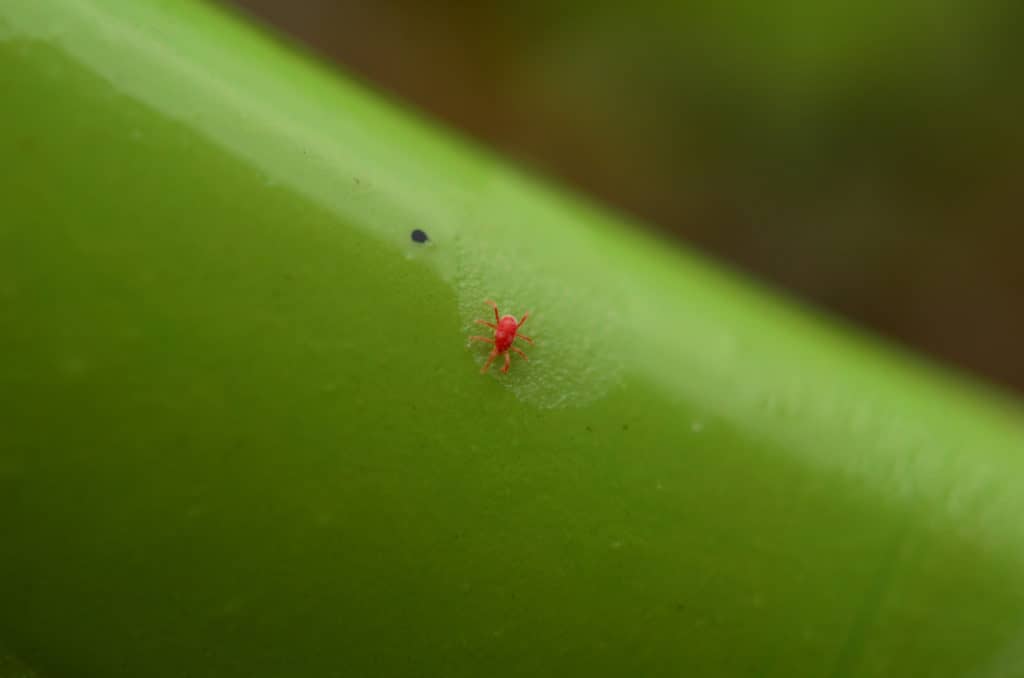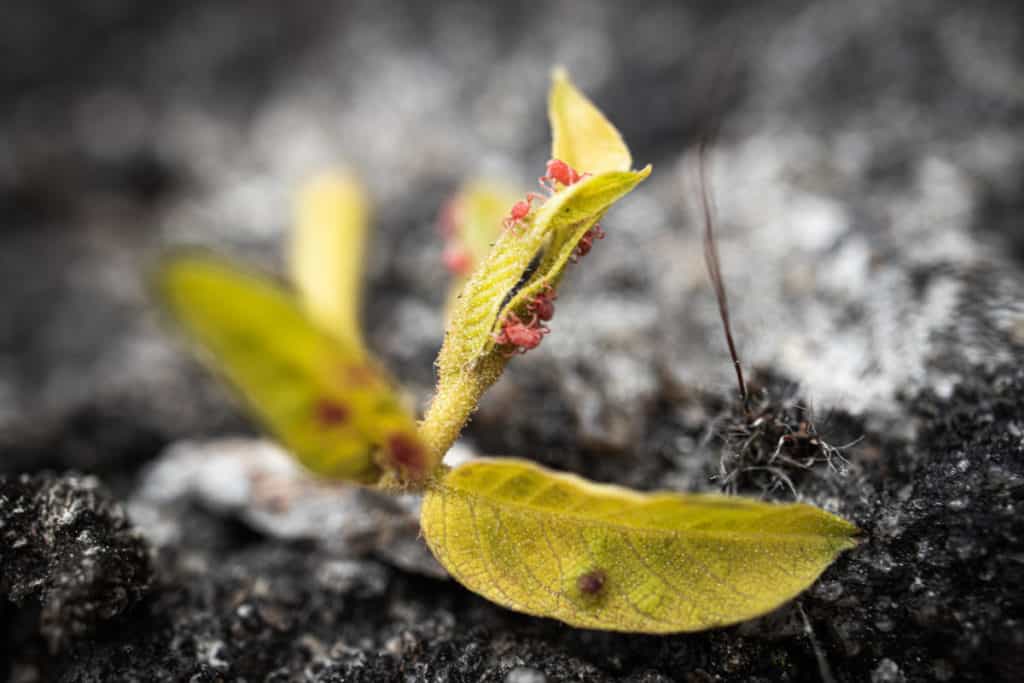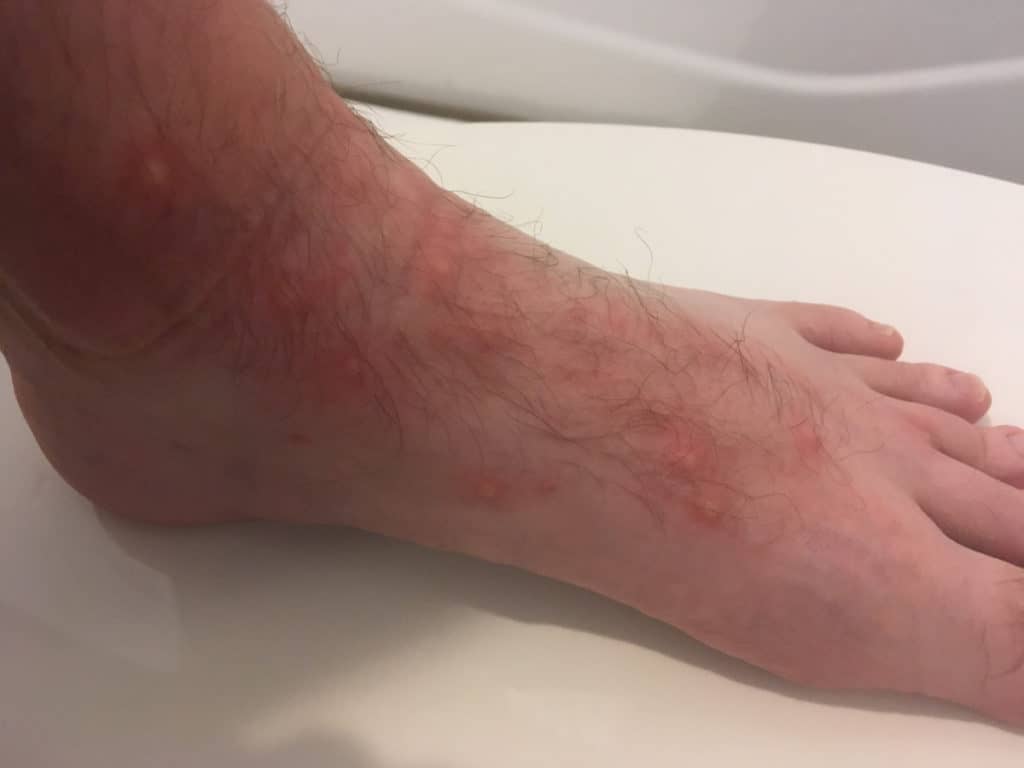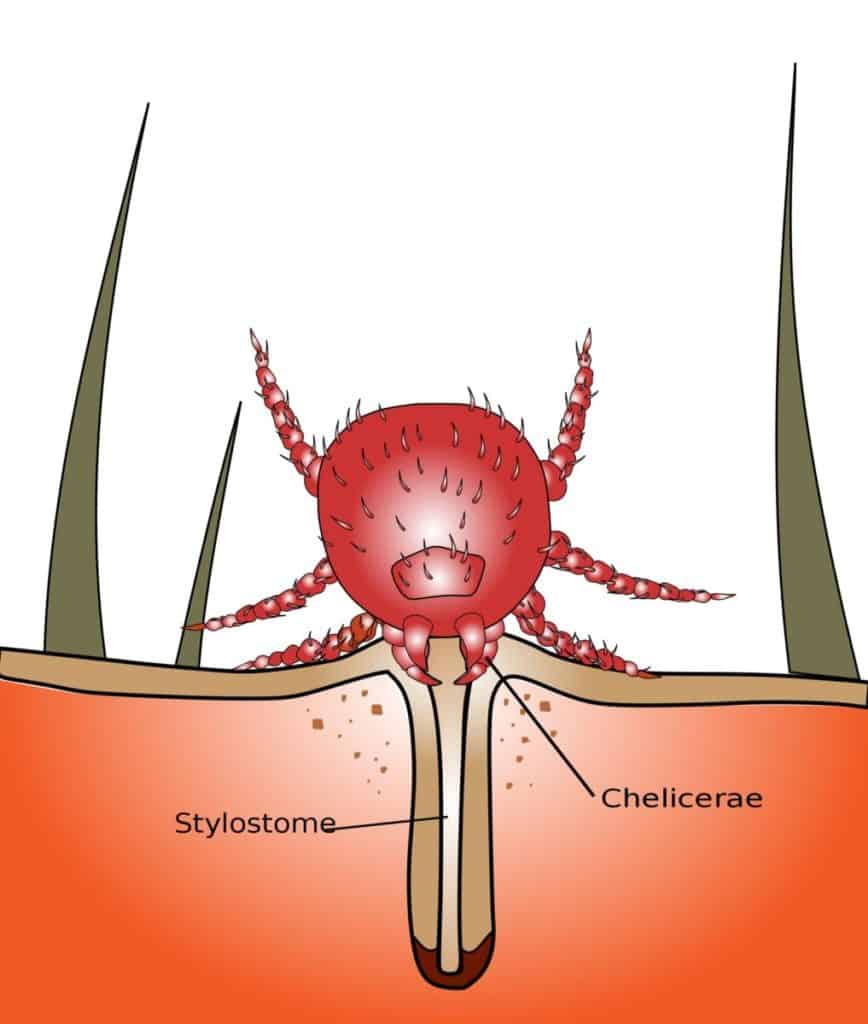While chigger mites and clover mites are not the same, they are both close relatives to ticks and spiders. Mites are considered arachnids, so these two organisms are not classified as insects. Just like all the other species of mites they lack wings and eyes and are also very small.
From what they eat to where they live- clover mites and chiggers are different in various areas. Read on to learn more as we explore what differentiates them from one other.
Appearance
Chiggers
These mites are barely visible to the naked eye because they are less than 1/150th of an inch – you will need a magnifying glass to see them. Chiggers are actually the larval form of the Trombiculidae mite. At close range, the adult Trombiculidae mite has eight legs, while its larva has only six.

Both the adults and larvae are oval-shaped, but the larvae have long hairs protruding from their bodies’ surface. The adults do not have these hairs. Also, the larvae are slightly larger compared to the adult.
Clover Mites
The clover mite is slightly bigger in size but smaller than the head of a pin. They measure roughly about 1/30 of an inch. That makes them visible to the naked eye compared to chiggers and Trombiculidae mites.

The adult clover mite is oval-shaped, it has eight legs, with the two front legs being twice as long as the other six. In fact, the front legs may be mistaken for antennae. Their long front legs allow them to walk faster, which explains how they cover a lot of ground quickly.
Location
Chiggers
Chigger mites tend to favor the outdoors. These larvae crawl up the grass blades, and as you or your pet passes by, they attach to your clothes or fur. Also, if you are in close proximity to a pet or clothing that has chiggers, it is possible to pick them up from there. Chiggers thrive in all countries worldwide. They favor fields and forests where they can attach to wild animals and rodents with ease. But do not be surprised to find them on your lawn.
Clover Mites
Clover mites inhabit the indoors but only at certain times of the year. They start off outdoors, and you may see them on your lawn. When they are in large numbers, they give the lawn a bronze hue. These mites love heavily fertilized fields and lawns, so you can expect to see them in newly installed lawns. However, once the lawn is established, their numbers diminish significantly.
Although they do not survive indoors for long, they tend to come into your house to escape the extreme weather. Clover mites are distributed in Africa, Asia, Europe, South America, North America, and Australia.
Time Of Year Are They Active
Chiggers
Chiggers are closely associated with the harvest season, so they appear in the late summer to early autumn, around September and November. They are nicknamed harvest mites, harvest lice, harvest bugs, or mower mites because they only appear during or after a harvest. While the harvest period is pretty short, the pesky mites can cause havoc in that brief period. The chiggers are most active when the ground temperature is 25 – 30 degrees Celsius.
Clover Mites
Clover mites are common during early to mid-spring when they love to climb up and down the sunny sides of buildings. They are sensitive to temperatures above 39 degrees Celsius and below 24 degrees Celsius. That means they avoid the cold temperatures of winter and the hot months of summer. You may see them enter your home in droves right in spring and fall.
What Do They Eat?
Chiggers
Chiggers feed on liquefied skin tissue. The nymphs and adult Trombiculidae mites feed on decaying insects and organic matter, but the chiggers must feed on animal tissue to mature. Their favorite feeding spots on human beings are the back of knees, between thighs, underarms, and in the crook of your elbow. They love to feed where the skin is thin and folded or where your clothing tightly fits against your body like sock and underwear brands.

Once having settled on a feeding spot, the chigger inserts its chelicerae (mouthparts) into your skin through a hair follicle or pore. It attaches itself and begins to secrete its saliva that liquefies the skin tissue. A chigger’s saliva contains proteolytic enzymes, which are instrumental in liquefying skin tissue on the inside.

The site around the bite hardens, forming a feeding tube called the stylosome. A chigger then slurps the liquified tissue. Unfed larvae have a deep red hue, while fully fed larvae are yellow in color. Once the larvae are fully fed, they fall onto the ground, where they molt into nymphs.
In cats and dogs, chiggers can be commonly found between the toes, around the nipple, on the chest and elbow folds, and around the ears.
Clover Mites
Clover mites are not carnivorous or scavengers. They are herbivorous, feeding on plants with a preference for clover. These mites suck the juices out of the plants, and they also feed on algae and mold. You will find them in fertilized lawns because of the young juicy plants growing there.
Clover mites have piercing mouthparts, which they use to rupture the cells of plants. The ruptured cells produce nutritious fluids that the cloves consume. Their bites leave small white spots on the leaves in what is commonly known as stippling. The plant sap is sufficient food to sustain the growth of the mites through all stages of life.
Are They Harmful To People Or Pets?
Chiggers
A chigger’s bite can be harmful to human beings depending on which chigger bites you. There are over 50 species of chiggers that bite people. The typical bite manifests as clusters around your lower legs or waist. A few hours after the bite, you will start to itch, and the itching lasts for several days. Following the itching, you will form blisters, a rash, and bumps on the site that may take one or two weeks to heal. That is a mild scenario.
If you are a man and the chigger bites your penis, you may develop Summer penile Syndrome. The condition is characterized by swelling, itching, and pain when urinating. Scratching the rash and blisters can break the skin, exposing you to an infection.
The good news is that most chiggers do not carry any diseases, so their bite, while annoying and irritating, is not fatal. However, bites from chiggers from the genus Leptotrombidium are found mostly in Asian Pacific regions, and Northern Australia carries Orientia tsutsugamushi, the agent that causes scrub typhus.
Scrub typhus is also known as bush typhus, and it can cause fever, muscle pain, and enlarged lymph nodes. In severe cases, it can cause bleeding, organ failure, and coma.
Chiggers also cause blisters, bumps, and rashes in dogs and cats.
Clover Mites
Because clover mites are not blood feeders, they pose no threat to human beings and pets. Despite their piercing mouthparts, they do not bite human beings, and also, they do not spread diseases.
The only danger clover mites present is to your wardrobe and fabrics. If you squash one of these mites, they leave a red stain that is not easy to get rid of. Unfortunately, they crush easily, so if they are all over your carpet, curtains and rugs easily leave unsightly red marks all over the place.
And because they are great at sneaking into your house through cracks and crevices, you may find yourself with hundreds of them in your space in no time. Plus, they love to congregate in groups.
Taxonomy
Chiggers
Chiggers belong to the animal kingdom, and their phylum is Arthropoda. There are more than 20 genera to this mite and over 50 species. Below is more on its general classification
- Subphylum: Chelicerata
- Class: Arachnida
- Subclass: Acari
- Order: Trombidiformes
It also belongs to the Trombidiodea superfamily and the family Trombiculidae.
Clover Mites
These mites also belong to the animal kingdom and the Arthropoda phylum. They belong to only one genus, unlike chiggers. Here is the rest of the classification of clover mites
- Class: Arachnida
- Subclass: Acari
- Order: Trombidiformes
Clover mites belong to the Tetranychidae family and genus Bryobia. Their species is Bryobia praetiosa.
Life Cycle Of A Chigger Mite
The female and males do not mate. The male deposits a spermatophore in a substrate, and the female insert it into its genital pores. Here the sperm fertilizes the eggs, and the female deposits the fertilized eggs into moist soil.
The eggs hatch into larvae in five to seven days. When the larvae attach to a human or animal host, they feed on their host’s skin tissue for 3 to 4 days before falling off. They stay for about a week to 10 days before they molt into a nymph on the ground. The nymph has eight legs and resembles an adult Trombiculidae mite. Nymphs molt for two weeks to a month to become complete adults.
The complete life cycle of Chigger (Trombiculidae) mites from eggs to adults is 50 to 70 days. Depending on the conditions, there can be one to five generations produced per year.
Life Cycle Of A Clover Mite
The female clover mites lay eggs that are viable through a process known as parthenogenesis. That means the eggs do not need to be fertilized by males because no male clover mites exist. The eggs are laid within the cracks and crevices of the house, where it is dry. They hatch when the temperature is between 20 and 30 degrees Celsius.
The females can lay up to 70 eggs, which take only 30 days to move from egg to adult. That is why their populations can explode quickly. The eggs hatch into larvae, which become nymphs, and the offspring is identical to the mother.
Because they are sensitive to extreme temperatures, they may reproduce two generations per year. But it is possible for them to have even more generations. Overwintering eggs hatch early in spring, and the adults become active as the temperature warm. These new offspring produce a second generation before hibernating in the summer.
| Chiggers | Clover mites |
| The male sperm fertilizes the egg | They reproduce through pathogenesis |
| They feed on animal skin tissue | Feeds on plants only |
| Measure 1/150th of an inch | Measure 1/30th of an inch |
| Some species are dangerous to human beings | They are not harmful to human beings |
| They come in over 20 genera and 50 species | They have only one genus and species |
| Active in late summer and autumn | Active in spring and fall |
Why Are Clover Mites and Chiggers Mistaken For Each Other?
Both mites are red in color, which explains why they are commonly mistaken for each other. Also, chiggers and clover mites tend to live in groups, so they may appear as a patch of red on the soil, vegetation, or in the house. At a glance, it can be hard to differentiate between the two.
They also both have eight legs, and their bodies are oval in shape. Finally, they can both be found outdoors even though clover mites migrate indoors during extreme temperatures.
How To Avoid Chiggers
- Wear long pants and shirts that have been treated with permethrin, an insecticide from pyrethroids. It is effective against disease-carrying organisms. Investing in mite repellent clothing and socks is effective because chiggers like to hang just a few inches off the ground, which is a vantage point for both non-detection and easy attachment to your clothes.
- Apply insect repellent like mosquito repellent to your skin to prevent chiggers from attaching.
- Keep your lawn mowed, and always trim the vegetation and weeds around your home. Short grass and less dense vegetation is inhospitable to chiggers.
- Once you enter your home, remove your clothing immediately and wash up thoroughly with hot water and plenty of soap. Wash your clothes in hot water as well and dry them in the sunlight or using a washing machine. Do not use cold water to wash the clothes because the larvae will not die.
How To Prevent Clover Mites From Entering Your House
- Remove all weeds and grass from around your structure’s foundation, leaving a two feet wide strip. The strip should feature pea gravel, which is smooth and makes it harder for the mites to move. Make sure the sides of the building receiving the most sunlight feature the strip. Clovers love sunlight and will climb the side of the building with the most sunlight.
- Seal the holes, gaps, and crack on the structure. Also, use a caulk gun to fill gaps. That prevents the mites from finding a way into your home.
- Do not heavily fertilize your lawn because clover mites multiply exponentially in lawns with a lot of fertilizer.
How To Treat A Chigger Bite
Chigger bites can be treated using home remedies or over-the-counter medications. To treat the bite site, begin by:
- Taking a cool shower when you begin to itch. This helps with the itching. If you cannot shower, apply cold compresses to the bite site. Some people prefer to sit in a cool bath, immersing the bite site in the cool water.
- If you have colloidal oatmeal, apply it to the area affected by the bite. Some shampoos, lotions, and moisturizers also feature colloidal oatmeal. The oatmeal acts as an anti-inflammatory agent and an emollient soothing the spot.
- If you prefer over-the-counter medication, consider calamine lotion or corticosteroid cream. You can also take oral antihistamines to help relieve symptoms like itching and hives.
The Wrap Up
Clover mites and chiggers may belong to the same phylum and subclass, but they are entirely different organisms. While one produces parasitic larvae, the other depends on plant life all its life.
However, the consensus is that both mites can be a nuisance to their respective hosts. Unfortunately, they cannot be said to be beneficial to animal life or plant life.
It is a good idea to always look out for them wherever you are.
Sources
https://www.colonialpest.com/dont-confuse-clover-mites-and-chigger-mites/
https://www.healthline.com/health/mite-bites
https://www.webmd.com/skin-problems-and-treatments/prevent-treat-chigger-bites#1
https://www.medicinenet.com/chiggers_bites/article.htm
https://hgic.clemson.edu/factsheet/clover-mites/
https://www.adamspestcontrol.com/pest-info/crawling-insects/chigger/chigger-resource-page/
https://www.cdc.gov/typhus/scrub/index.html
https://www.sciencedirect.com/topics/agricultural-and-biological-sciences/trombiculidae
https://extension.missouri.edu/publications/g7358
http://npic.orst.edu/factsheets/PermGen.html
https://www.sciencedirect.com/topics/agricultural-and-biological-sciences/parthenogenesis
https://www.hopkinsallchildrens.org/Patients-Families/Health-Library/HealthDocNew/Chiggers
